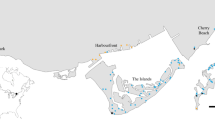Abstract
Several species of fire ants, well known for their painful stings, have spread from their native ranges and have become invasive pests, notably Solenopsis geminata, Solenopsis invicta, and Solenopsis richteri. Here, I report the first known exotic spread of another fire ant, Solenopsis nr. saevissima, a South American species now established on the French West Indian island of Guadeloupe. In 2008, I first found this shiny yellow fire ant at Plage de Viard beach on Guadeloupe. Genetic analyses indicated that this species was close to the yellow–brown variant of S. saevissima known only from Western Amazonia, but not an exact match. I returned to Guadeloupe in 2011 and found S. nr. saevissima at Plage de Viard plus five additional sites along a >20 km stretch on the east coast of Basse-Terre, from the Jarry commercial shipping port in the north to Plage Roseau in the south. It seems most likely that S. nr. saevissima arrived in Guadeloupe from South America in a commercial shipment unloaded at the port in Jarry. It is unclear whether this species will develop into a major new problem. Solenopsis nr. saevissima may simply replace another pernicious fire ant, S. geminata, which apparently arrived in Guadeloupe from South America several 100 years ago.


Similar content being viewed by others
References
Allen CR, Epperson DM, Garmestani AS (2004) Red imported fire ant impacts on wildlife: a decade of research. Am Midl Nat 152:88–103. doi:10.1674/0003-0031(2004)152[0088:RIFAIO]2.0.CO;2
Buren WF, Allen GE, Whitcomb WH, Lennartz FE, Williams RN (1974) Zoogeography of the imported fire ants. J N Y Entomol Soc 82:113–124
Franquinho-Aguiar AM, Wetterer JK (2006) Mealybugs (Hemiptera: Pseudococcidae) and Argentine ants (Hymenoptera: Formicidae) in 19th century Madeira. Bol Mus Mun Funchal 57:29–33
Krahe HB (2005) Impact of the red imported fire ant (Solenopsis invicta) on two species of sea turtle hatchlings. Florida Atlantic University, Thesis
Morley BDW (1953) The ant world. Penguin Books, London
Prahlow JA, Barnard JJ (1998) Fatal anaphylaxis due to fire ant stings. Am J Forensic Med Pathol 19:137–142
Ross KG, Gotzek D, Ascunce MS, Shoemaker DD (2010) Species delimitation: a case study in a problematic ant taxon. Syst Biol 59:162–184
Shoemaker DD, Ahrens ME, Ross KG (2006) Molecular phylogeny of fire ants of the Solenopsis saevissima species-group based on mtDNA sequences. Mol Phylog Evol 38:200–215. doi:10.1016/j.ympev.2005.07.014
Trager JC (1991) A revision of the fire ants, Solenopsis geminata group (Hymenoptera: Formicidae: Myrmicinae). J N Y Entomol Soc 99:141–198
Wetterer JK (2011) Worldwide spread of the tropical fire ant, Solenopsis geminata (Hymenoptera: Formicidae). Myrmecol News 14:21–35
Wetterer JK (2013) Exotic spread of Solenopsis invicta (Hymenoptera: Formicidae) beyond North America. Sociobiology 60:53–63
Wheeler WM (1908) The ants of Texas, New Mexico and Arizona (Part 1). Bull Am Mus Nat Hist 24:399–485
Wheeler WM (1910) Ants: their structure, development and behavior. Columbia University Press, New York
Wheeler WM (1926) The natural history of ants. From an unpublished manuscript in the archives of the Academy of Sciences of Paris by René Antoine Ferchault de Réaumur. Translated and annotated by William Morton Wheeler. A, Knopf, New York
Acknowledgments
I thank M. Wetterer for comments on this manuscript; L. Davis for identification; D. Shoemaker for genetic analyses; P. McCormack and G. Alpert for the photos; W. O’Brien for GIS help; D.P. Wojcik and S.D. Porter for compiling their valuable FORMIS bibliography; R. Pasos and W. Howerton of the FAU library for processing so many interlibrary loans; and the Fulbright Foundation, the National Science Foundation (DES-0515648), and Florida Atlantic University for financial support.
Author information
Authors and Affiliations
Corresponding author
Rights and permissions
About this article
Cite this article
Wetterer, J.K. A South American fire ant, Solenopsis nr. saevissima, in Guadeloupe, French West Indies. Biol Invasions 16, 755–758 (2014). https://doi.org/10.1007/s10530-013-0534-8
Received:
Accepted:
Published:
Issue Date:
DOI: https://doi.org/10.1007/s10530-013-0534-8




